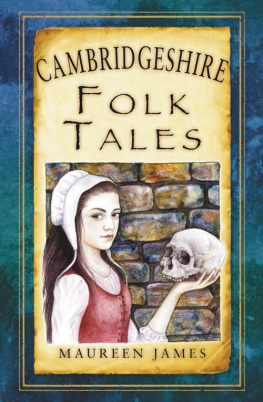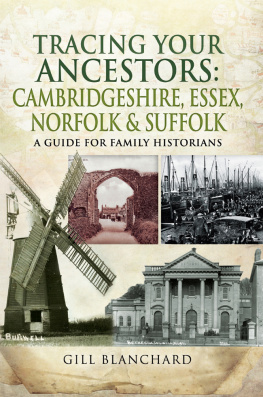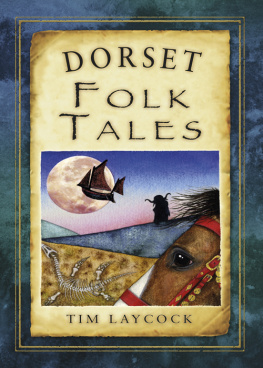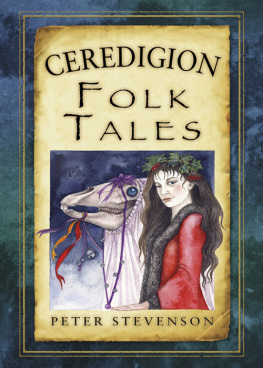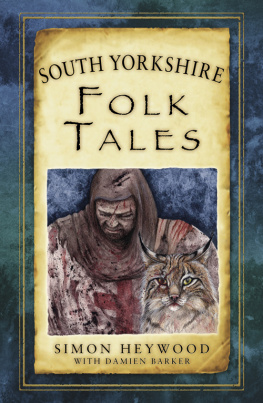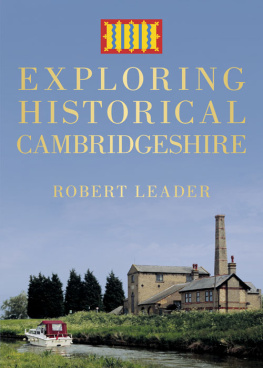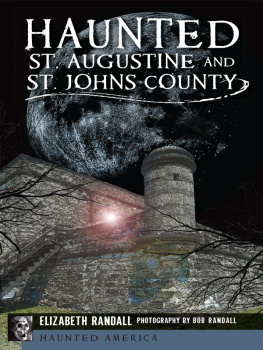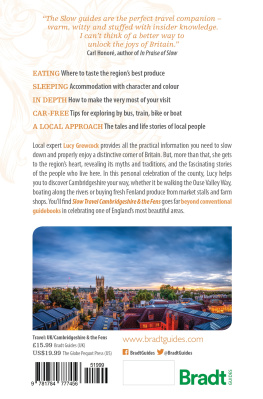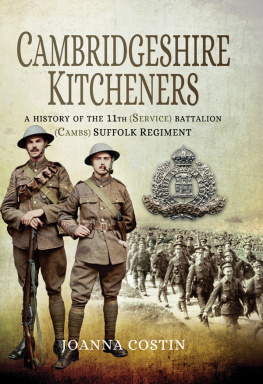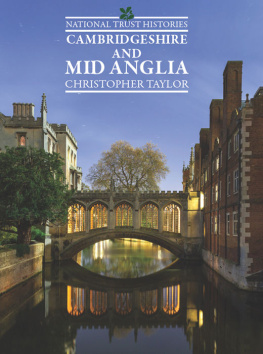
For all the Fen Tigers, who I hope will appreciate
and enjoy this book. And to Aunty Joan and Uncle Tom, whose love and inspiration stay with me always.
This book follows on from my other volume in the same series, namely Lincolnshire Folk Tales . For both I have drawn on research carried out on the folklore and folk tales of the flatlands for my PhD. However, it would not have been possible without the initial inspirations provided by Barbara Johnson and Heather Falvey that revived my passion for history back in 1985. I am also indebted to Liz Wright for persuading me that I could write professionally, Paul Jackson for showing me the power of the spoken story, and Del Reid for being a tower of strength for so many storytellers. I also would like to thank the late Doug Stone of Chatteris and Peter Hewitt of March, for sharing not just with me, but with many, many others, their love of local history. Similarly, I owe a debt of gratitude to the folklorists of the past, especially Enid Porter and the late W.H. Barrett (and his informants). Numerous other storytellers and historians have also inspired me on my journey, but with regards to Cambridgeshire and the Fens, these include Hugh Lupton, Malcolm Busby, Polly Howat, Mike Petty, Celia and Geoff Taylor, Judith Legge, Gordon Phillips, Nicky Stockman, Alan Lamb, Ernie Hall and the late Arthur Dunham. Finally, I need to thank my husband Stuart for helping with the illustrations, and he and the rest of my family for their patience and understanding.
Maidens garter, fenmans charter,
Neighbours brats, fishermans floats,
fire a glowing, reaper mowing,
are things never interfered with.
C ONTENTS
Tom Hickathrift Legendary Giant
The Ely and Littleport Riots
Elijahs Ghost (A Tale of a Toadman)
The Legend of Whittlesey Mere
Mr Leech and the Devil
Robin Good-fellow
Black Dogs, Will o the Wykes and Lantern Men
The Legend of Bulldog Bridge
Mark Twain and Tall Stories of the Fens
Two Fat Geese
The Fearless Girl
The Clerks Revenge
The Witches of Warboys
The Witch-finders in Cambridgeshire
Matcham and the Drummer Boy
The Gruesome History of Caxton Gibbet
The Beastly Butcher of St Neots
Gog Magog and the Land of the Giants
PC Peak of Wicken Fen
The French Prisoners at Norman Cross
The Sufferings of Elizabeth Woodcock
Etheldreda Princess, Abbess and Saint
Bricstan of Chatteris
The Devil, the Church and the Stone Cross
The Mystery of the Whirlin Cakes
King Canute and the Fens
The Prowess of Osbert Fitz Hugh
Hereward the Saxon
King John and Wisbech
Legends of the English Civil War

P LACES I NCLUDED IN THIS B OOK
1 Alconbury
2 Aldreth
3 Balsham
4 Bodsey
5 Bottisham
6 Bourn
7 Brampton
8 Brandon Creek
9 Burwell
10 Cambridge
11 Caxton Gibbet
12 Chatteris
13 Cherry Hinton
14 Coates
15 Coppingford
16 Cottenham
17 Diddington
18 Doddington
19 Easton
20 Eldernell
21 Elsworth
22 Ely
23 Grantchester
25 Gt Abington
26 Gunwade Ferry
27 Hemingford Grey
28 Huntingdon
29 Impington
30 Keyston
31 Leverington
32 Litlington
33 Littleport
34 March
35 Molesworth
36 Norman Cross
37 Parson Drove
38 Peterborough
39 Prickwillow
40 Quanea
41 Ramsey
42 Raveley
43 Snailwell
44 Soham
45 St Ives
46 St Neots
47 Stilton
48 Stretham
49 Stuntney
50 Sutton
51 Trumpington
52 Upware
53 Waldersea
54 Wandlebury
55 Wansford
56 Warboys
57 West Wratting
58 Whittlesey
59 Whittlesey/Mere
60 Wicken Fen
61 Wimblington
62 Wisbech
63 Witchford
64 Woodcroft
On its borders Hickathrifts castle once stood, and in its mazes
Hereward sought shelter during his long struggle
for independence.
Jonathan Peckover, 1868
Like the other books within this History Press series, this volume is a collection of folk tales linked to the landscape and to a specific county. The county in this case is Cambridgeshire, formed in 1965 by the joining of the historic county of Cambridgeshire with the Isle of Ely and, in 1974, with the addition of Huntingdonshire and the Soke of Peterborough (part of the unitary authority).
T HE L ANDSCAPE : T HEN AND N OW
The present county of Cambridgeshire is bordered on the north by Lincolnshire, on the east by Norfolk and Suffolk, on the south by Essex and Hertfordshire and on the west by Bedfordshire and Northamptonshire.
A glance at an Ordnance Survey map will show that much of the northern part of the county consists mostly of very low-lying land, the silt and peat fenland, interspersed with similarly low-lying islands.
Daniel Defoe, in his Tour Through the Eastern Counties of England (1722), noted that the Fens were the sink of no less than thirteen counties being subject regularly to inundation by the rivers Cam or Grant, the Great Ouse and Little Ouse, the Nene, the Welland, and the Lark.
The situation is still the same today, and the area still carries the run-off water from Bedfordshire, Buckinghamshire, Cambridgeshire, Essex, Huntingdonshire, Leicestershire, Lincolnshire, Norfolk, Northamptonshire, Oxfordshire, Rutland, Suffolk and Warwickshire. However, there is now an elaborate system of moving the flood waters out to the Wash.
With the shrinkage of the peat, almost all of the Fenland rivers are now above the level of the land, some many feet higher, making a strange sight with the river banks rising high above the roads that run beside them. There are also numerous drainage dykes crossing the Fens, into which the Fenland waters are pumped on their way to the sea. It has been estimated that when all the pumping stations in the Fens are busy they can move a total of ten million gallons of water per minute.
But what of the landscape before all the pumps and drains?
In 1868 Jonathan Peckover of Wisbech described the county before the extensive drainage of the seventeenth century:
the inland water extended as far south as Cambridge, and touched on the east, Downham, Brandon and Mildenhall; Soham being upon a lengthy neck of land which stretched out into the morass. On the west side were St Ives, Somersham, Ramsey, Peterborough and Peakirk. The sea entered at three outlets from the north, the widest of which passed by Wisbech, another at Spalding and a third at Lynn, the sea coast from Lynn running northward and passing a short distance from Castle Rising. There was thus between Wisbech and Lynn, a large oblong island of marshland, upon the upper part of which was Walpole, and on the lower side Hickathrifts castle at Emneth There was also another larger island called Holland between Wisbech and Spalding, which with the one just mentioned formed the northern border of the great inland swamp of waters called the Fens. Upon the southern borders of Holland were Crowland and Guyhirn. In the waters of the Fens were scattered a great number of islands, upon some of the principal of which were situated Thorney, Whittlesey, March, Chatteris and Littleport. The largest island was a straggling piece of ground which was called the Isle of Ely, near the north of which was Ely and the south, Haddenham.
Next page
